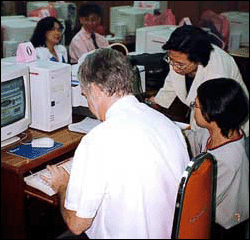|
Chemical Spill Guided Tour: Part 9
 |
|
Photo courtesy of U.S. EPA, Region 1
|
CAMEO is used by thousands of people and organizations, and it has been introduced into about 50 countries. It has been translated into French, Spanish, Chinese, and Swedish, and the ALOHA gas dispersion model has been translated into Japanese as well.
CAMEO has been adopted by the United Nations Environment Programme's APELL (Awareness and Prevention of Emergencies at the Local Level) program, which promotes planning and preparedness for chemical accidents, especially in newly-industrializing countries.
At right, a hazardous chemicals specialist from the U.S. Environmental Protection Agency helps students learning to use CAMEO in Bangkok, Thailand.
Click any link below to see what some CAMEO components look like in Spanish.
ALOHA in Spanish
CAMEO in Spanish
MARPLOT in Spanish
|


